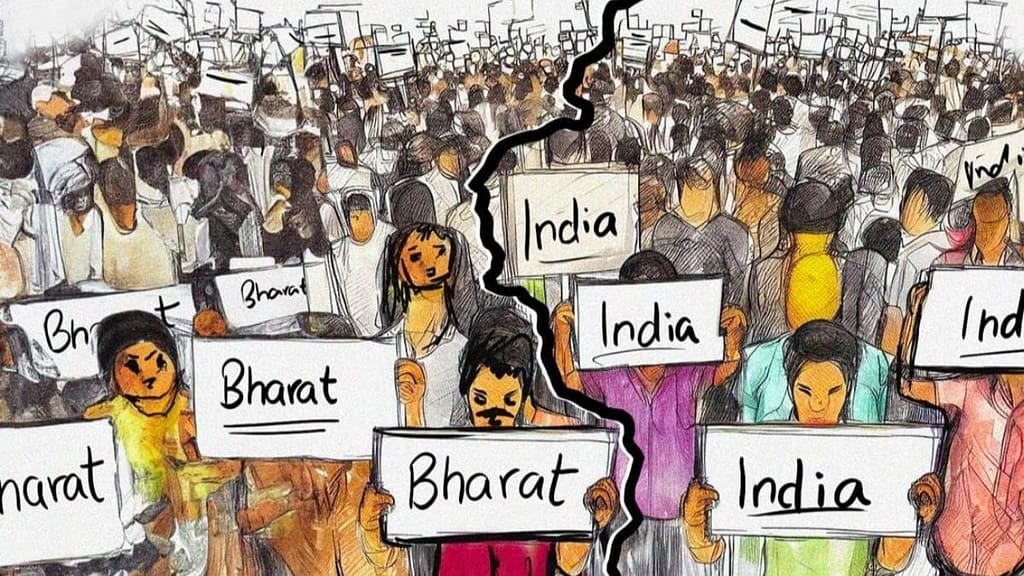New Delhi: The notion of changing the name of India to Bharat has gained steam recently and has sparked a heated debate across the country. The name change from India to Bharat will take place gradually to give organisations and people time to adjust to the new name and any resulting changes. There will be a gradual transition to the new emblems in official documents, money, and other national symbols. The renaming of India as Bharat is a remarkable and audacious move towards preserving its rich cultural past and embracing its diverse identities. The nation sends a strong statement to the rest of the world as it sets out on this trip, demonstrating how firmly established it is in its history while simultaneously embracing the chances and difficulties of the future.
The shift involves more than just a name change; it also consists of the spirit and feelings that each Indian possesses. The term “Bharat” has significant cultural and historical connotations. It is a representation of the country’s rich history and has roots in old Sanskrit literature.
While the idea of transforming India into Bharat is alluring, the question arises: what will it actually cost? And how changing the name of India to Bharat will impact the economy?
It’s obviously not as simple as it seems, and there are a lot of benefits and drawbacks as well, including the following:
Preservation of Culture and Legacy: One of the main reasons is the desire to protect and advance India’s rich cultural legacy. A historical name with roots in Indian mythology and history, Bharat represents the country’s rich cultural identity.
Promotion of Regional Languages: The transition recognises the linguistic variety of the nation and attempts to encourage regional languages and dialects alongside Hindi and English. It is viewed as a means of celebrating and preserving India’s rich linguistic heritage.
National Pride: Many supporters of the name change think it will build a closer connection between people and their cultural origins by instilling a sense of pride in the nation’s long history and traditions.
Tourism Promotion: The country’s rebranding as Bharat is anticipated to increase tourism because it will draw attention to its rich history, varied traditions, and cultural landmarks.
Language Diversity: With more than 19,000 languages spoken in India, the country is well known for its linguistic diversity. All linguistic groups might not respond well to the country’s new name, Bharat. Achieving a balance that values linguistic diversity while fostering a shared identity would take time and effort.
Administrative Challenges: A country’s official name can only be changed through a complex and expensive process. It entails upgrading government forms, money, signs, and other infrastructure. Not to be overlooked are the financial expenditures and administrative strain of such a transformation.
Political Controversy: The renaming of the nation could be a contentious political issue that draws focus away from more crucial governance issues. Any such reform must be implemented via a democratic and consensus-driven approach.
Economic cost: As we cannot ignore the logical way, this is one of the most significant factors. The following are some economic costs associated with altering a nation’s name:
- Rebranding expenses: Changing a country’s name necessitates revising all official papers, money, logos, and signs. It could lead to enormous government spending and impact the budget.
- International contacts: A name change might necessitate renegotiation and amendment of international treaties, accords, and trade agreements, which might result in a breakdown of current business contacts.
- Tourism and investment: A name change may momentarily confuse or put off visitors and potential investors, which could have an impact on tourism earnings and foreign direct investment.
- Administrative Fees: Updating stationery, websites, and other communication materials would be necessary, adding to the costs for businesses and government organisations.
- Export and Import Confusion: Companies may experience export and import confusion due to a name change in overseas markets.
- Intellectual Property: Protecting the intellectual property rights connected to the nation’s prior name may be difficult and expensive.
- Brand awareness: The nation can lose its identity and brand awareness in foreign markets, which could affect exports and tourism.
- Currency Redesign: Redesigning and reprinting currency notes and coins can be expensive if the currency’s name changes.
- Transition Period: During the transition, administrative and logistical issues could cause disruptions in both corporate and government operations.
- Global Perception: A name change may alter how the world views the nation, which may impact decisions about foreign commerce and investment.
In addition to numerous economic factors, it is difficult to anticipate them earlier; there may be some unpredicted incidents that can affect economic cost.
However, it is expensive to change a country’s name. Darren Olivier, an intellectual property lawyer and blogger based in South Africa, developed a formula that Outlook used to estimate the amount for India, which was estimated to be around Rs 14,000 crore. In 2018, when Swaziland changed its name to Eswatini, Olivier utilised this model. His idea equates renaming a country to rebranding initiatives at big businesses. According to the model, a large company’s average marketing expenditures are around 6% of its total sales, whereas rebranding expenses might reach 10% of the marketing budget.










